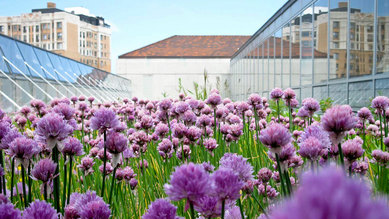Landscape over Structure
A green approach for realizing a site's performance and placemaking potential
Maximize our site’s capacity. Lower our energy costs. Provide the community with a positive environmental impact.
These are often-heard requests when clients express their goals for site development. Space is typically at a premium for developers, universities and municipalities, especially in urban areas. They want to accommodate a wider range of uses, meet key energy and stormwater performance goals, and provide a unique experience for users and visitors. For tight urban settings or sites that extend over buildings or underground parking, one way to meet all these goals is to create landscape areas over structure.
Landscape over structure, whether intensive or extensive, can dramatically expand a site’s development envelope and potential. Other benefits include: energy conservation and improved thermal performance for the building underneath; reduction of urban heat island effect; reduction and filtering of stormwater run-off; air quality improvements; increased biodiversity and habitat; and creation of dynamic public open space.
An integrated design approach is the best way to address the technical issues associated with intensive landscape installations over structure. Architects, landscape architects and structural experts are needed to address drainage, waterproofing, weight loads, soil type and depth, and plant species selection. This interdisciplinary collaboration is the key to a successful project.
The involvement of urban designers and the skilled selection of landscape and hardscape materials can create such compelling spaces that users often cannot tell they are over structure at all. Whether it’s a mixed-use redevelopment like the Scottsdale Waterfront, a civic space like Dallas’ AT&T Performing Arts Center, or eight acres of open space on Epic Systems’ corporate campus, these dynamic, programmable spaces provide tremendous value to the owner and the community.
